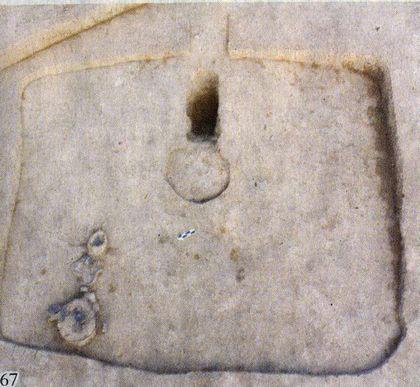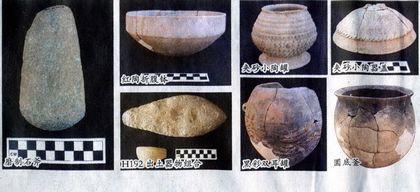The achievements of the excavation at the Weijiawopu site in Chifeng, Inner-Mongolia in 2011
Chinese Institute of Archaeology
Source - http://www.kaogu.cn/en/detail.asp?ProductID=3343
The weijiawopu site is located on a mesa hill which is 2km northeast to the Weijiawopu village, Wenzhong town, Hongshan District, Chifeng city, Inner-Mongolia. It was discovered firstly in May 2008 and the Inner-Mongolia Institute of Archaeology carried out the re-investigation and coring at the site. Also this site was integrated planned and grids were laid out theoretically. As a result, it was preliminarily confirmed that it is a settlement site with a ring trench dating to the Honxgshan Culture and covers about 9.3ha area inside the ring trench.
From the early July to the end of September, 2009 and from the early July to the early October, 2010, the joint archaeology team consisting of the Inner-Mongolia Institute of Archaeology and the Frontier Archaeology Center of Jilin University, carried out excavations twice at the site. During 2nd July to 21st October, 2011, the third excavation was carried out by the joint archaeology team.
The excavation area in 2011 is in the northeast part of the Weijiawopu site. There are 42 grids with 10mX10m laid out in all and the total excavation area was 4202 square meters. After the excavation, there were 39 house remains, 56 ash pits, 5 kitchen-ranges, 2 ash trenches confirmed and large number of potteries, stone tools, clam artefacts and animal bones were unearthed.

56 ash pits could be categoried into circular, elliptical, near circular and a few irregular shapes based pits opening. While the walls of the ash pits were mostly straight or oblique straight and a few pits were bag-shaped. As for the bottom of the pits, the majority is flat but some of the pits’ bottoms were slope or undulating. The artefacts unearthed from the ash pits included potteries, stone tools, clam shells and animal bones etc.
The 39 house remains were all semi-subterranean type and mostly in shape of square or square with round corners, but a few were slightly trapezoidal. While these houses used to have straight or oblique straight walls and flat or slightly undulating floors. In the center of the most house remains, there were kitchen-ranges connected with fire intake. And in the walls parallel to the fire intake, there were doorways which were mostly slope but a few had flat steps. There were large number of potteries, stone tools, clam shells and animal bones unearthed from the house remains.
The five kitchen ranges had the same structure and similar size with those discovered in the house remains and they were presumed to be the remains of the totally destroyed houses. Also the sporadic trample surface distributed around a few kitchen ranges can show the above. Only a few pottery shards were unearthed from the most kitchen ranges and there were nothing unearthed from a few kitchen ranges.
The two ash trenches were respectively located in the east part (G3) and the southwest part of the excavation area of 2011. They were in south-north and northwest-southeast direction. The deposit in the ash trenches could be roughly divided into three layers based on the soil property, the soil color and the unearthed artefacts.

According to the quality of the potteries, the unearthed potteries could be categoried into sandy clays and mud clays. As for the quantity, the number of sandy clays is larger than the mud clays and most are black sand clays and grey sand clays. Also most sand clays have even-sized sandy grains which are mainly gray white quartz sand, but some of sandy clays are partly brown and dark brown due to the firing or usage. While, the majority of the sandy clays have thick and high water absorption but crispy walls due to the low heating control. The ornamentation on the sand clays’ bodies are mainly decorated zigzag design, engraved lines and stamp patterns, and a few additional heap patterns, embossing patterns, etc. However, on the bottom of the potteries, the ornamentation is mainly twill patterns. In addition there are buttons or nail patterns on a few lips or the bodies of the sand clays. The categories of sand clays include cylindrical tanks, oblique mouth wares, caldrons and cups, etc. but the cylindrical tanks are the most.
The majority of the unearthed stone tools are grinding stones, and then the chipping stones and suppressing microlith. Among the grinding stones, there are grinding slabs, grinding rods, stone axes, stone ploughs, stone containers and gravels. The chipping stones are mainly broken stone hoes or stone picks etc. The microlith are mostly cores and blades. In addition, there is one exquisite suppressing stone arrowheads.
Compared to other artefacts, the bone artefacts are less. However, there are large number of clam artefacts and clam decorations.
The investigation and excavation in 2011 and the preliminary analysis to the unearthed materials richened our knowledge on the date, character, nature and the construction process of the site. As a ring-trench settlement site with largest investigation and excavation area dating to the Hongshan Culture which is focused by the international academic circle, the Weijiawopu site supplied significant materials for exploring the origin of Chinese civilization, ancient eco-environment and subsistence and other key academic issues. At the same time, some artefacts unearthed from the site have similar characters with the same contemporaneous categories unearthed from the Central Plain. Combined with the analysis on these artefacts, the material and cultural exchange between the central plain and the northeast China is reflected. Therefore, the materials from the Weijiawopu site became the significant for studying ancient cultural exchange. (Translator: Zhai Shaodong)